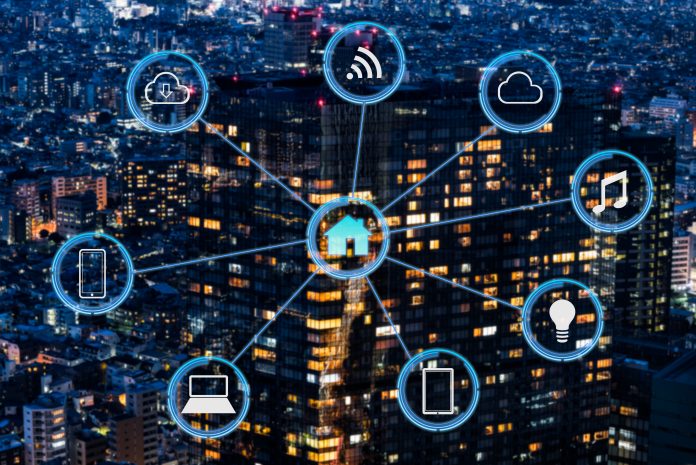Here, the relationship between IoT and the modern office environment is explored further
From shared documents and digital timesheets to updates in computing, employees have never been afraid of change and continue to evolve. Currently, the ‘smart office’ concept is something that has gone from sci-fi suggestion to become a logical and widely-embraced next step in the world of work.
Imagine a working environment where lighting and heating are automatically adjusted depending on the number of people in the room, sensors help to log time and manage productivity, and repetitive tasks are automated. These innovations are no longer in the far future, as the Internet of Things (IoT) is projected to reach 26 billion connected devices by 2021.
The number of potential benefits that come with workplace smart devices is not in question, but the adoption of IoT poses several risks around the security and financial cost of implementing these changes – especially for small businesses. In order to make an informed decision, business owners need to carefully balance the pros and cons, to identify which elements of IoT will bring the most improvement and which are best avoided.
The benefits of a smart office
With the surge in popularity of smart speakers like Google Home or Amazon’s Alexa, having smart controls in the home has become commonplace. As a result, the evolution of embracing this technology in office spaces doesn’t feel like unfamiliar or futuristic territory, but rather an opportunity to utilise new technologies to improve the workplace.
From more familiar examples like speakers and lighting to smartpens that automatically backup notes, effective IoT usage will quickly become integrated as part of a wider smart office setup, where automation by software on laptops supports wider efficiencies that smart devices themselves enable.
In many cases, added efficiencies come in the form of sensors. These can be used to enhance building security, note which meeting rooms are in use or to adjust heating and lighting for a more comfortable environment, automating a number of smaller tasks daily tasks.
At this point, it is important to clarify that while many offices are becoming increasingly paperless, this is not considered automation, it is just a different medium for completing the same tasks. Instead, automation will directly reduce the number of small tasks staff are responsible for conducting, allowing for the workflow to be improved due to a streamlined routine.
Wellbeing
A win-win situation for everyone involved in a business is improving staff wellbeing. Keeping staff happy will help foster positivity, focus, dedication and improved health. A report by the Social Market Foundation found that happy employees could be up to 20% more productive, demonstrating the dramatic positive impact improvements to employee care can be.
IoT can help to boost wellbeing in a number of ways. From smart lighting and thermostats to air quality monitors and wellness wearables, data can optimise a working environment to increase people’s concentration and to ensure that incidents of stress and ill-health are minimised.
Wellbeing is increasingly considered a vital piece in the operation of a successful business, and a high priority for millennials entering the workforce. A company that clearly prioritises the importance of its staff’s needs is going to become increasingly attractive to the best talent.
The risks
For as many benefits as smart devices can bring to the office, there is also a serious security concern that needs to be considered when adding any new devices to a company network, the attack surface. Put simply, this is the number of points of entry that a hacker could use to access a system.
Any internet-connected device could potentially be used to gain access if it is running an outdated operating system or is still using the default password. Adding unnecessary devices to any network means increased risk and more opportunities for a vulnerability to develop. This is not to say that IoT should be avoided completely on security grounds, but it is crucial that any devices that do join a network justify their place through saving money or improving efficiency and are only included after the benefits and the risks are weighed together.
Another concern that may be slowing businesses’ uptake of IoT is the rapid progression of technology. One report has predicted that while the number of smart devices continues to grow, many devices installed prior to 2018 are likely to become obsolete by 2020. With the possibility of investing large sums in technology that may well become obsolete quickly, at what point should business owners decide to jump onto a moving train for fear of missing it altogether?
There is no simple answer to this question, but it underlines the importance of thorough research. Taking the time to keep up-to-date with the latest trends in business technology will not only help to inform decisions around new tech but could help to keep businesses ahead of the game when it comes to new security threats.
Finding a balance
The smart office has already arrived, the question is, how much does a business need it? Most companies will not benefit from adding internet connectivity to every single device, but IoT is more than just a trend; it is the evolution of the modern workplace and will need to be adopted eventually to keep pace with competitors and employee expectations.
Before adopting any new technology, it is vital that consideration is given to balancing the security risks of its implementation. Adding a large number of devices simultaneously would not only be an excessive strain on IT staff resources but could make the company more susceptible to a data breach.
Taking the time to plan the implementation of IoT is an excellent opportunity to assess the current condition of the business’ overall security, ensuring that office-based devices are patched and protected with antivirus and endpoint security software. Making sure that existing security measures are operating effectively is an excellent base to begin adding carefully considered additions, rather than the alternative – poor implementation compounded by the addition of further vulnerable devices.
IoT devices are not always a definitive answer to every challenge but are increasingly useful in cutting out distractions and reducing day-to-day costs. When implementing their use around the office, businesses should take a moderated approach that suits the needs of their company.











